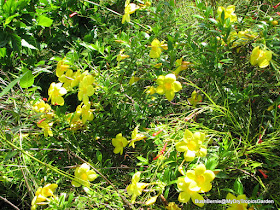Out in the still rather parched garden, there are the regular end-of-summer bloomers.
The Tabebuia heterophylla is blooming, although this blooming cycle started a little later in the summer this year compared to previous years. The pale, pale light pink flowers are rather unassuming in amongst all the green foliage, and from a distance are hard to spot. When you get up close however, you notice that brilliant yellow throat and crinkly texture of the petals.
Another of the tall, tall trees on the property that has begun its summertime blooming cycle rather late is the Citharexylum spinosum. Finally though there are wonderful white flower sprays covering the branches and attracting all sorts of insect life.
There are still the occasional bunch of blooms on the Plumeria obtusa, although they're now becoming harder and harder to spot as its blooming cycle comes to an end.
The Allamanda cathartica 'Sunee' is showing off its golden yellow flowers once more. These bright cheery blooms certainly add a great splash of colour in the front garden bed.
There are now rather large flowerheads on the old Ixora coccinea at the back of the courtyard.
Other Ixoras are also blooming nicely as well. This lemony yellow variety is one of my favourites.
The trusty old common red Gerbera always makes me smile. It's one of the most reliable year-round bloomers at my place.
The fabulous white Musseanda philippica 'Aurore' is covered in its white bracts and little star-shaped yellow flowers.
It's great to see the white flower sprays of the Salvia leucantha 'White Velour' popping up out in the tiered garden beds.
Another of my lovely Mussaendas, Mussaenda philippica 'Bangkok Rose', is on the wane, but still looks fabulous against the background of the red Russelia.
I'm seeing the purple-pink plumes of the Pennisetum advena 'Rubrum' one more,
and I've been surprised to see quite a few blooms on the dwarf Azalea growing in one of the front garden beds. That's not a common sight this late in the summer.
My maturing Lagerstroemia indica shrubs are showing a few more flowerheads this year.
One of my Lagerstroemia speciosa trees is now covered in buds and some of its pretty purple flowers have opened.
Out in the shadehouse garden a couple of my pass-along Brassocattleya (Bc) Maikai hybrids are showing off for the first time. I really love the form and the colour of these little Orchids.
One of my Hemerocallis, Hemerocallis 'Rue Madelaine' is turning out to be one of the longest blooming Daylilies in my little Daylily patch. I've never seen a Daylily blooming this late in the Summer before. Don't you just love the surprises that greet you when you have a garden?
One of the blooms I'm particularly enjoying at the moment is my beautiful Water Lily. It's another pass-along plant, so I have no idea of its varietal name. I just call it 'Gorgeous'!
I'm joining Carol for Garden Bloggers' Bloom Day



































